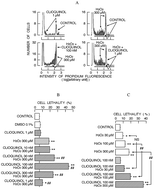Clioquinol, a lipophilic Zn2+ chelator, augments and attenuates the cytotoxicity of H2O2: a bell-shaped response curve of the effects of the drug
Abstract
Clioquinol, a lipophilic Zn2+ chelator, has emerged as a potential novel therapeutic agent for several diseases such as cancer and Alzheimer's disease. Clioquinol has different effects on the intracellular Zn2+ concentrations in rat thymocytes, depending on its concentration and extracellular Zn2+ levels. In this study, we examined the effect of clioquinol on cells under oxidative stress induced by hydrogen peroxide (H2O2) by using a conventional flow cytometric technique with appropriate fluorescent probes. We observed a bell-shaped relationship between the clioquinol concentration and changes in H2O2 cytotoxicity; H2O2-induced cytotoxicity was the highest at a clioquinol concentration of 100 nM. Zn2+ chelators significantly decreased the clioquinol-induced increase in H2O2 cytotoxicity. A bell-shaped curve was observed between the increase in H2O2-induced cytotoxicity by clioquinol and the intracellular Zn2+ concentrations, although the maximal increases in Zn2+ levels were induced by 300 nM clioquinol. In addition, clioquinol at concentrations ≥100 nM exerted antioxidant activity by decreasing the cellular oxidant levels. Thus, clioquinol can exert pro-oxidant or antioxidant effects, depending on its concentration and the extracellular concentration of Zn2+. Because of the unique Zn2+-dependent effects and toxicological profile of clioquinol, clioquinol should be considered for clinical use.


 Please wait while we load your content...
Please wait while we load your content...